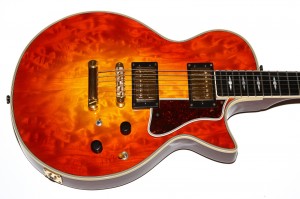
The Guild Nightbird is a very cool guitar. Yes, it looks like a Les Paul, but it’s hollow with a very unique internal design which makes for a wonderful sound. The problem with Nightbirds is that they usually shipped with Ken Armstrong or EMG pickups which don’t hold a candle to the vintage Guild HB1s in my opinion. I originally bought this guitar because of the lure of real HB1s in a Nightbird, only to be disappointed when I opened it up and found Fender HB1s. I then sold the guitar, after which it was sold again to the guy who I originally bought it from, who then contacted me to see if I would do the work to upgrade the pickups. We Guild collectors tend to work together, so this bit of provenance is only slightly unusual.
For a dissertation on the differences between the many pickups found in Guild electric guitars, check out my article entitled, Guild Full-Sized HB1 and SD1 Pickup Variations.
The Guild Nightbirds that I’ve encountered have come equipped with only a single tone and volume knob, but the tone knob is also a push/pull coil-splitting control. In addition to the normal pickup selector switch, the Nightbird also includes a phase switch. This combination of controls makes for some slightly complex wiring that I didn’t want to disturb, so I set about documenting the layout since I couldn’t find any references online.
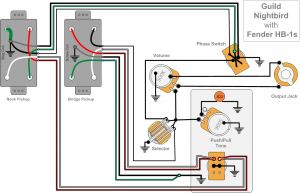
The main bit of weirdness I discovered was he fact that the green wire on the bridge pickup was combined with the black ground wire, but this was done inside heat-shrink tubing on the control end which gave the appearance of the green wire starting on the pickup and never coming out the other side. I went nuts trying to trace that wire and finally got out the multimeter and determined that it had been spliced with the ground lead.
Another bit of complexity involved the fact that there seemed to be two black wires running to the controls: a thick one (ground) and a thin one (signal). Getting those two right was kind of important, but only if proper function was desired (a little wiring humor, that). Furthermore, there was only one black wire on the pickup side. The thick black wire in the control cavity was actually the ground wire from the multi-conductor cable wrapped in shrink-wrap tubing in the control cavity.
Replacing the Fender HB1s with the NOS Mid-90s Guild HB1s involved mapping the existing wiring harness to the new pickups. Being able to solder the pickups was a boon because I would not have to mess with the pots and switches at all. Soldering in a control cavity is never fun, especially in the deep chamber of a mostly hollow Nightbird. One slip and I’d be scorching wood in a $2000 guitar which is something I’d rather not have to explain to the owner.
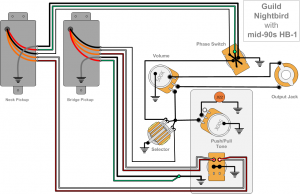
With all my preparations surrounding the wiring, I’d managed to overlook something that caught me by surprise after I’d soldered all the electronics into place, and after all my careful planning I felt like an idiot for letting it happen.
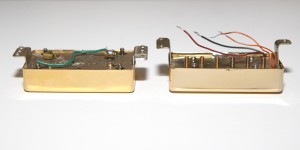
I’d known about this depth issue from past attempts to install a vintage HB1 in a non-Guild guitar only to be stymied by the insufficient depth of the pickup route in the guitar. In this case, the Guild Nightbird had plenty of depth, but the adjustment screws weren’t long enough.
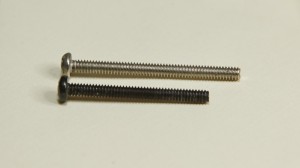
So how do the vintage HB1s sound in this guitar? In a word, magnificent. I actually commented to the owner that these pickups make this the perfect guitar. It has beautiful clean tones, raucous growly crunch tones, and creamy high distortion, all with the articulation of boutique pickups and the added fun of coil-splitting and a phase switch. I’ve owned $8000 Les Paul R9s, and this thing crushes them dead with the HB1s in there. And it looks better, too! Subjective hyperbole? Perhaps, but having owned a few Gibson R9s and R8s, I’d push them all out of the way to get to this guitar with its mighty HB1 pickups; it’s just that good. To be fair, this guitar has an ebony fretboard, meticulously crafted details and a very special top. The Guild Nightbird was really a high-end instrument in its day.
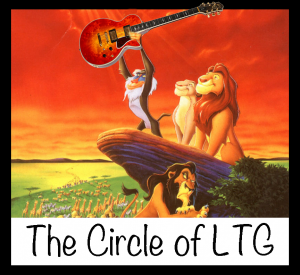
This is a truly special instrument, and as much as I’d like to assume that I’ll once more claim it as my own, I have a feeling that the Guild HB1s just make it so great that it will never get sold again. Here’s hoping I’m wrong.
Donate: PayPal Crypto:
ETH: 0x0AC57f8e0A49dc06Ed4f7926d169342ec4FCd461
Doge: DFWpLqMr6QF67t4wRzvTtNd8UDwjGTQBGs
